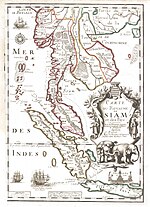Tambralinga Tāmbraliṅga | |||||||||||
|---|---|---|---|---|---|---|---|---|---|---|---|
| c. 2nd century CE–1277 | |||||||||||
 Tambralinga at their largest extent in 1244 after the Jaffna conquest | |||||||||||
| Capital | Nakhon Si Thammarat (on the Malay Peninsula) | ||||||||||
| Common languages | Old Malay, Mon, Sanskrit, Old Khmer | ||||||||||
| Religion | Hinduism, Buddhism | ||||||||||
| Government | Monarchy | ||||||||||
| King | |||||||||||
• 1230–1262 | Chandrabhanu | ||||||||||
• 1263–1277 | Savakanmaindan | ||||||||||
| History | |||||||||||
| c. 2nd century CE | |||||||||||
| 927 | |||||||||||
• First mentioned in medieval Chinese sources | 970 | ||||||||||
| 775–969 | |||||||||||
• Late Independent | 970–1277 | ||||||||||
| 1003 | |||||||||||
| 1025 | |||||||||||
• Tambralinga invaded Sri Lanka | 1247 | ||||||||||
• Fall of Tambralinga | 1277 | ||||||||||
• Refounded and became Nakhon Si Thammarat Kingdom | 1278 | ||||||||||
| |||||||||||
| Today part of | Thailand, Malaysia | ||||||||||
| History of Thailand |
|---|
 |
|
|

Tambralinga was an Indianised kingdom located on the Malay Peninsula (in modern-day Southern Thailand), existing at least from the 2nd to 13th centuries CE.[1][2]: 19 It possibly was under the influence of Srivijaya for some time,[a] but later became independent from it or were generally allies rather than conqueror and vassal.[2]: 23 The name had been forgotten until scholars recognized Tambralinga as Nakhon Si Thammarat (Nagara Sri Dharmaraja). In Sanskrit and Prakrit, tām(b)ra means "copper", "copper-coloured" or "red" and linga means "symbol" or "creation", typically representing the divine energy of Shiva.[4][5]
Tambralinga first sent an embassy to China under the Song dynasty in 1001. In the 12th century it may or may not have been under the suzerainty of the Burmese Pagan Kingdom and a kingdom of Sri Lanka.[6] At its height in the mid-13th century, under King Chandrabhanu, Tambralinga was independent, regrouping and consolidating its power and even invading Sri Lanka.[7] By the end of the 13th century, Tambralinga was recorded in Siamese history as Nakhon Si Thammarat, under the suzerainty of the Tai Sukhothai Kingdom.[8]
- ^ a b สืบพงศ์ ธรรมชาติ (2014). "อารยธรรมแดนใต้ ตามพรลิงค์ ลังกาสุกะ ศรีวิชัย และศรีธรรมราชมหานคร (เมืองสิบสองนักษัตร)" [The Civilization of Tambralinga Langasuga Sivichai and Si Thammarat Mahanakhon (Muang Sibsongnagasat)]. Asian Journal of Arts and Culture (in Thai). 14 (1). Archived from the original on 24 April 2024.
- ^ a b c d e f g Cite error: The named reference
noonsukwas invoked but never defined (see the help page). - ^ "๑ สหัสวรรษ แห่ง "พระนิยม"". Fine Arts Department (in Thai). Archived from the original on 25 October 2023. Retrieved 26 October 2023.
- ^ Roland Braddell (1980). A Study of Ancient Times in the Malay Peninsula and the Straits of Malaccam and Notes on Ancient Times in Malaya. Malaysian Branch of the Royal Asiatic Society. p. 398.
- ^ Stuart Munro-Hay (2001). Nakhon Sri Thammarat: The Archaeology, History and Legend of a Southern Thai Town. White Lotus Press. p. 22.
- ^ Michel Jacq-Hergoualc'h (2002). The Malay Peninsula: Crossroads of the Maritime Silk-Road (100 BCE–1300 CE). Brill. p. 400.
- ^ Craig J. Reynolds (2019). Power, Protection and Magic in Thailand: The Cosmos of a Southern Policeman. ANU Press. pp. 74–75.
- ^ Michel Jacq-Hergoualc'h (2002). The Malay Peninsula: Crossroads of the Maritime Silk-Road (100 BCE–1300 CE). Brill. p. 489.
Cite error: There are <ref group=lower-alpha> tags or {{efn}} templates on this page, but the references will not show without a {{reflist|group=lower-alpha}} template or {{notelist}} template (see the help page).